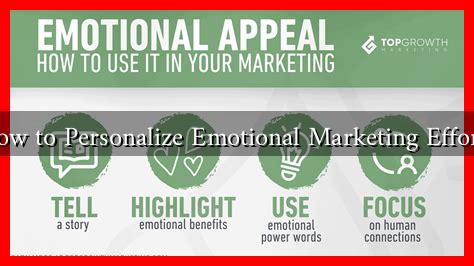-
Table of Contents
How to Personalize Emotional Marketing Efforts
In today’s competitive landscape, emotional marketing has emerged as a powerful tool for brands looking to connect with their audience on a deeper level. By tapping into the emotions of consumers, businesses can foster loyalty, drive engagement, and ultimately increase sales. However, to truly harness the power of emotional marketing, personalization is key. This article explores effective strategies for personalizing emotional marketing efforts, supported by examples and case studies.
Understanding Emotional Marketing
Emotional marketing is the practice of using emotions to influence consumer behavior. It goes beyond traditional marketing by appealing to feelings such as happiness, sadness, fear, and nostalgia. According to a study by the American Marketing Association, emotionally connected customers are more than twice as valuable as highly satisfied customers. This statistic underscores the importance of creating emotional connections through personalized marketing efforts.
Strategies for Personalizing Emotional Marketing
To effectively personalize emotional marketing, brands can implement several strategies:
- Segment Your Audience: Understanding the different segments of your audience is crucial. Use data analytics to identify demographics, preferences, and behaviors. For instance, a skincare brand might segment its audience based on age, skin type, and purchasing history to tailor emotional messages that resonate with each group.
- Utilize Customer Data: Leverage customer data to create personalized experiences. This can include using past purchase behavior to recommend products or sending personalized emails that reflect the customer’s interests. For example, Amazon excels at this by suggesting products based on previous purchases, creating a sense of understanding and connection.
- Craft Relatable Stories: Storytelling is a powerful way to evoke emotions. Brands should create narratives that reflect the values and experiences of their target audience. For instance, Nike’s “Just Do It” campaign often features real athletes overcoming challenges, which resonates emotionally with consumers.
- Engage Through Social Media: Social media platforms provide an excellent opportunity for personalized emotional marketing. Brands can interact with customers directly, respond to comments, and share user-generated content that highlights customer stories. For example, Coca-Cola’s “Share a Coke” campaign encouraged customers to find bottles with their names, creating a personal connection.
- Use Visual and Sensory Elements: Incorporate visuals, colors, and sounds that evoke specific emotions. Research shows that colors can influence emotions; for instance, blue can evoke trust, while red can create excitement. Brands like Airbnb use stunning visuals to evoke feelings of adventure and belonging.
Case Studies: Successful Personalization in Emotional Marketing
Several brands have successfully implemented personalized emotional marketing strategies:
- Spotify: Spotify’s “Wrapped” campaign provides users with personalized year-in-review statistics, showcasing their listening habits. This not only engages users but also evokes nostalgia, making them feel valued and connected to the brand.
- Hallmark: Hallmark’s marketing strategy revolves around emotional storytelling, particularly during holidays. By personalizing messages for different occasions, they create a sense of intimacy and connection with their customers.
- Apple: Apple’s marketing often focuses on the emotional benefits of its products, such as creativity and connection. Their ads frequently feature real-life stories of users, making the brand relatable and emotionally resonant.
Measuring the Impact of Personalized Emotional Marketing
To assess the effectiveness of personalized emotional marketing efforts, brands should track key performance indicators (KPIs) such as:
- Customer engagement rates
- Conversion rates
- Customer retention rates
- Social media interactions
- Brand sentiment analysis
Utilizing tools like Google Analytics and social media insights can help brands measure the impact of their emotional marketing strategies and make necessary adjustments.
Conclusion
Personalizing emotional marketing efforts is essential for brands looking to create meaningful connections with their audience. By segmenting audiences, utilizing customer data, crafting relatable stories, engaging through social media, and using sensory elements, brands can evoke emotions that drive loyalty and sales. Successful case studies from companies like Spotify, Hallmark, and Apple illustrate the effectiveness of these strategies. As the marketing landscape continues to evolve, embracing personalization in emotional marketing will be crucial for brands aiming to stand out and resonate with consumers.

